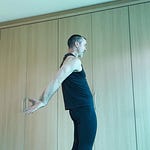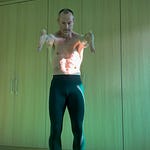Theoretically, this one should be easy,, as all you really do is sequentially apply each of the flavours one after the other. So, you’d drop your tummy, reach your arms then pivot your head backwards and up around your soft palate. Of course you’d do this whilst paying attention to soften and go of the soft parts inside you, letting them drop down into your bowl. Do this three to six times and drop the arms, then wait…
What you’ll then experience is something yogis call ‘the full yogic breath, only this version is free! Meaning, all you do is let go, drop your arms and wait for the body to breathe you. Make sure you don’t get in the way, which means applying any kind of unnecessary physical, mental or emotional tensions.
One way of helping you do this is by applying the four S’s.
When you drop your arms See yourself standing there. Simply see yourself standing there, whilst allowing other stuff inside and outside of you to happen. Then Soften what you can, especially the three P’s of the perineum, pelvis and peritoneum (stomach sack). And if it hasn’t happened yet, Smile as you wait for the body to breathe for you.
All of this will help let you get out of the way and allow “yoga do you”.
When you experience the full breath happening to you, it is nothing short of liberating. I mean, it’s momentary, but isn’t that the point? It points us towards a place where we are listening, feeling, and allowing the breath to happen. We are dancing with life! Or rather, we are accepting the invitation life is always offering us.
Some of you may see me doing something with my hips, and all I say is well done! It’s pretty obvious if you’ve been paying attention over the last few months of posts. It’s less important than you think, though more fundamental than even I yet appreciate… meaning don’t force it to happen, rather knows it’s just part of keeping the bowl whole in this final shape. It allows the breath to come in and out without letting it seep out of the container…
Remember, the whole act of yoga is pretty simple. You build part of your container/structure by learning how it interacts with the outside world (Yama). You then learn how you best interact with yourself (Niyama) and fold this directly into the first structure. You now have structure/container (Asana) into which you can begin building energy (Pranyama). Your senses then become fascinated (absorbed/Pratyahara) into this energy, and it builds (concentrates/Dharana) until it overflows into the rest of the body (meditation/Jhana). After which, your CNS expands, opens which feels blissful.*
I many ways the full favour breath is a beginners version of yoga, as you need to maintain your container whilst reaching and simultaneously letting go. Then you need to learn to let go and let ‘yoga do you’.
If you have had a go at this, please let me know. From my own experiences, this is a truly nourishing practice, one which is way more rewarding and nourishing than its simple shapes may show. It also holds secrets which will enhance all the breathing techniques I’ve learned. So if you haven’t had a go, I’d recommend you go back to the beginning and try it out.
Thank you for your time, and do leave a comment 🙏
*And for those of you who didn’t know, the steps to yoga as outlined here, this is all taken from the steps as outlined by Patanjai. It’s just that here I am highlighting the physical aspects which hold and anchor the other bodies within the process of letting ‘yoga do you’.












Share this post